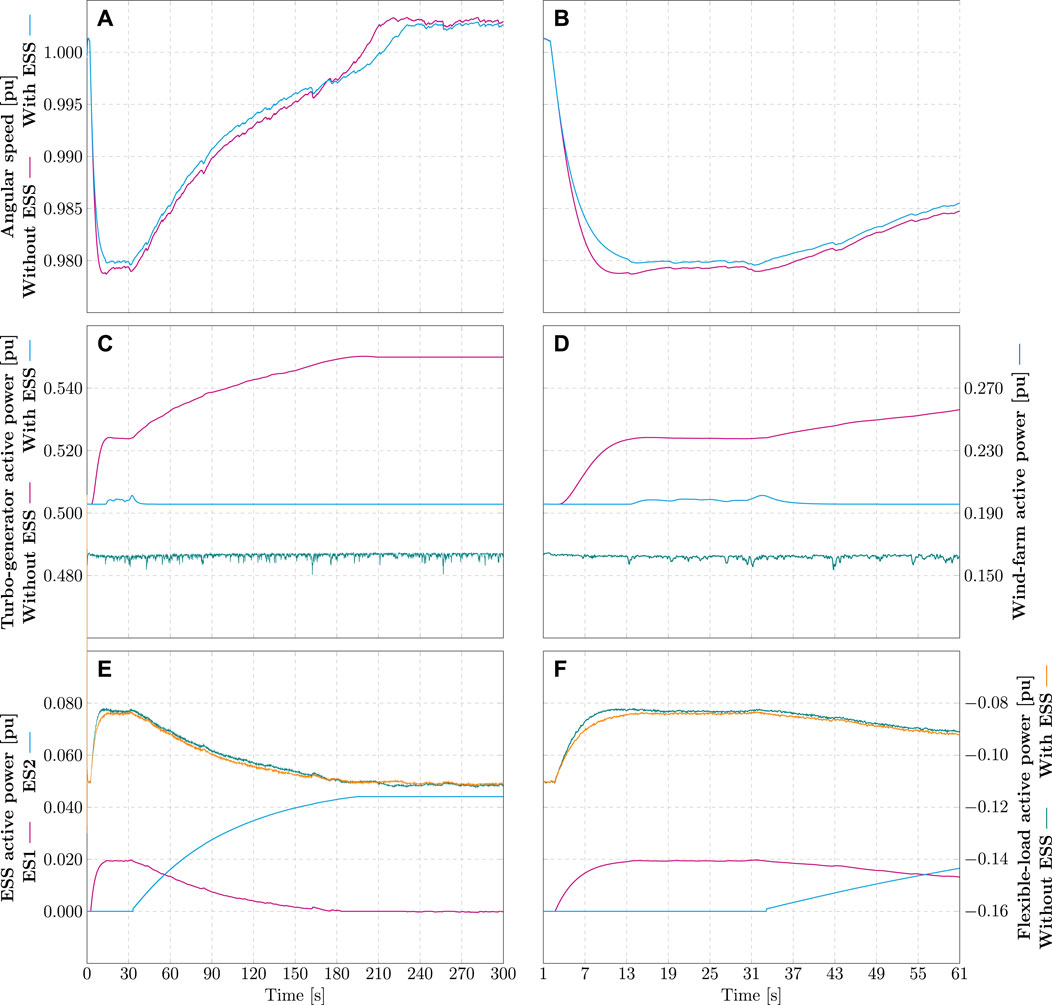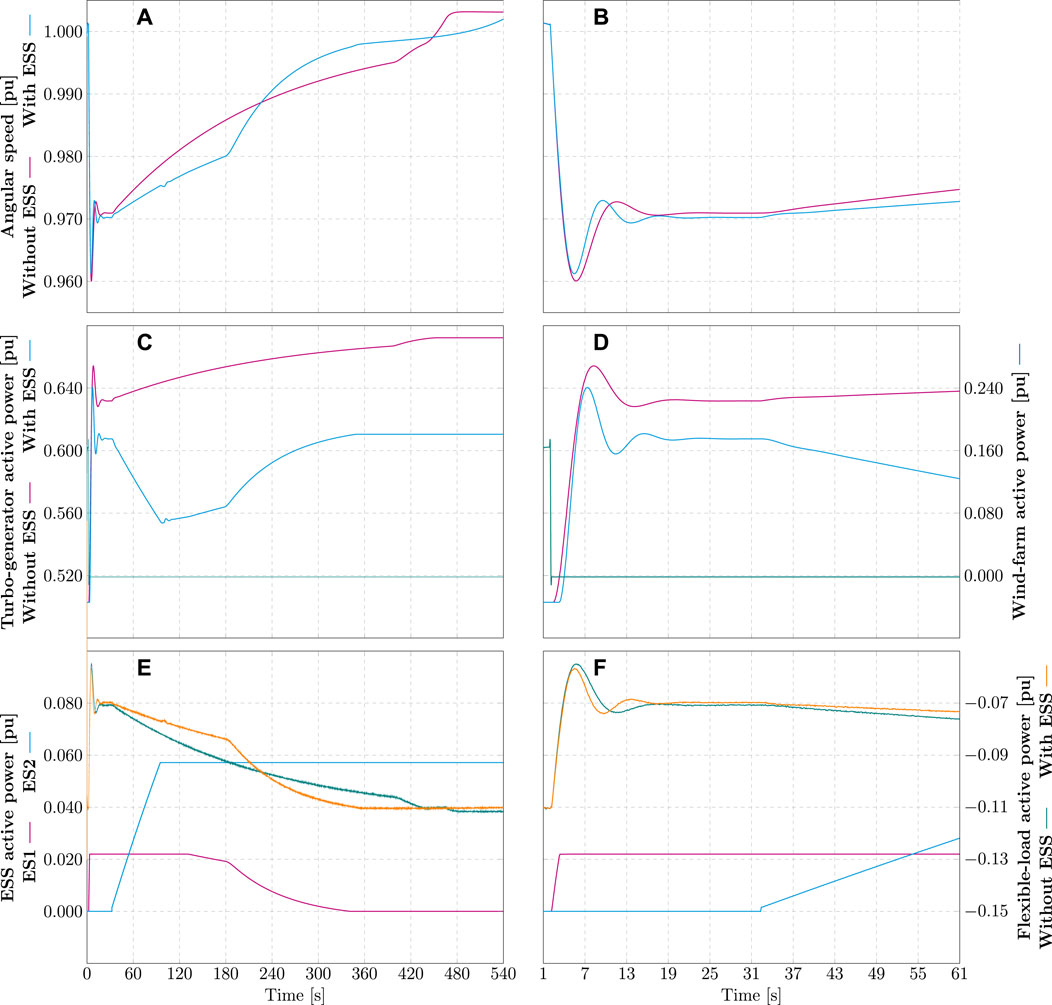Sizing of Hybrid Energy Storage Systems for Inertial and Primary Frequency Control
- 1Department of Electric Power Engineering, Norwegian University of Science and Technology, Trondheim, Norway
- 2Department of Industrial Engineering, University of Trento, Trento, Italy
A corrigendum on
Sizing of Hybrid Energy Storage Systems for Inertial and Primary Frequency Control
by Alves, E. F., Mota, D. d. S., and Tedeschi, E. (2021). Front. Energy Res. 9:649200. doi: 10.3389/fenrg.2021.649200
In the original article, there was a mistake in Figures 9 and 10, and Tables 1 and 2 as published.

FIGURE 9. Case study behavior during a load increase of 3 MW with and without the proposed ESS: normalized angular speed (A) during the whole transient and (B) detail of the first minute; turbo-generator and wind farm active power in pu (C) during the whole transient and (D) detail of the first minute; active power of the ES devices responsible for primary control (ES1) and secondary control (ES2) (E) during the whole transient and (F) detail of the first minute.

FIGURE 10. Case study behavior during the wind farm disconnection under full production (12 MW) with and without the proposed ESS: normalized angular speed (A) during the whole transient and (B) detail of the first minute; turbo-generator and wind farm active power in pu (C) during the whole transient and (D) detail of the first minute; active power of the ES devices responsible for primary control (ES1) and secondary control (ES2) (E) during the whole transient and (F) detail of the first minute.

TABLE 1. Parameters of the ACPS of an offshore oil and gas platform in the Norwegian continental shelf and the requirements for its converter-interfaced ESS.
There was a mistake in the parameters of the validation model presented in Section 3 Results [available in the reference Alves, E. F. (2021)]. The normalized moment of inertia reported in the article (M = 5.1 s) was wrongly multiplied by 4 in the MATLAB/Simulink model. Due to this error, Figures 9 and 10 reported incorrect dynamics, and Tables 1 and 2 reported incorrect values. The values for parameters (ta− t0) and (tb− ta) in Table 1 were incorrectly reported as 25 s and 15 s, respectively. The correct values are 11 s and 18 s, respectively. The value for parameter Ees1 in Table 2 was incorrectly reported as 101.76 kWh, the correct value is 60 kWh. In addition to Figures 9 and 10, and Tables 1 and 2, corrections have subsequently been made to various reported values throughout the article, namely in Section 3 Results, Sub-sections 3.1 study: a wind-powered offshore platform in the North Sea, 3.2 Sizing of the Energy Storage System, and 3.3 Sizing Validation. The corrected Figures 9 and 10, and Tables 1 and 2 appear below.
The authors apologize for this error and state that this does not change the scientific conclusions of the article in any way. The original article has been updated.
References
Keywords: low-inertia systems, energy storage, inertial control, primary control, frequency stability, power system design
Citation: Alves EF, Mota DdS and Tedeschi E (2021) Corrigendum: Sizing of Hybrid Energy Storage Systems for Inertial and Primary Frequency Control. Front. Energy Res. 9:718210. doi: 10.3389/fenrg.2021.718210
Received: 31 May 2021; Accepted: 21 June 2021;
Published: 12 July 2021.
Edited by:
Hong Fan, Shanghai University of Electric Power, ChinaCopyright © 2021 Alves, Mota and Tedeschi. This is an open-access article distributed under the terms of the Creative Commons Attribution License (CC BY). The use, distribution or reproduction in other forums is permitted, provided the original author(s) and the copyright owner(s) are credited and that the original publication in this journal is cited, in accordance with accepted academic practice. No use, distribution or reproduction is permitted which does not comply with these terms.
*Correspondence: Erick Fernando Alves, erick.f.alves@ntnu.no
 Erick Fernando Alves
Erick Fernando Alves Daniel dos Santos Mota
Daniel dos Santos Mota Elisabetta Tedeschi
Elisabetta Tedeschi